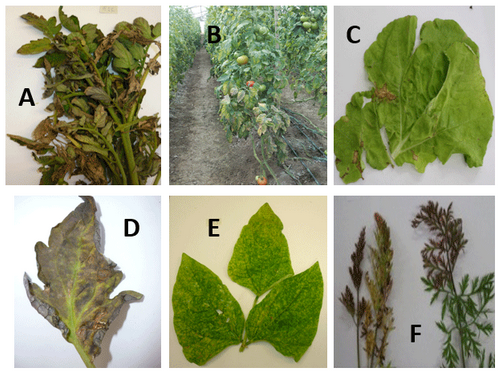Detection of Orthotospovirus in a suburban vegetable-producing area
Main Article Content
Abstract
Orthotospoviruses are RNA viruses transmitted by thrips (Thysanoptera: Thripidae). They have been considered one of the most economically important pests since the last century and today the losses caused by TCSV keep being an important factor to take into account in the different vegetable and grain producing areas in Cuba. Seventy-two samples of tomato, lettuce, carrot, cow pea, and pepper showing characteristic symptoms of infection by orthotopoviruses were collected in 2018-2020 (November to January) at the "Las Piedras" farm, Guanabacoa. The samples were analyzed by DAS-ELISA to detect TSWV, GRSV and TCSV. Twenty-six samples, corresponding to tomato and cow pea, resulted positive. These results corroborate the possibility of using serological techniques to detect orthotopoviruses in areas of intensive tomato production like “Las Piedras” farm and suggest that the cow pea crop can act as a viral host. The presence of orthotospovirus in tomato constitutes a serious risk for production of other crops of high economic impact because of the wide host range and the incidence of its transmitting vector in the producing areas of potato, tobacco, beans and other vegetables.
Article Details

This work is licensed under a Creative Commons Attribution-NonCommercial 4.0 International License.
Aquellos autores/as que tengan publicaciones con esta revista, aceptan los términos siguientes:
- Los autores/as conservarán sus derechos de autor y garantizarán a la revista el derecho de primera publicación de su obra, el cual estará simultáneamente sujeto a la Licencia Creative Commons Attribution-NonCommercial 4.0 International (CC BY-NC 4.0) que permite a terceros compartir la obra, siempre que se indique su autor y la primera publicación en esta revista. Bajo esta licencia el autor será libre de:
- Compartir — copiar y redistribuir el material en cualquier medio o formato
- Adaptar — remezclar, transformar y crear a partir del material
- El licenciador no puede revocar estas libertades mientras cumpla con los términos de la licencia
Bajo las siguientes condiciones:
- Reconocimiento — Debe reconocer adecuadamente la autoría, proporcionar un enlace a la licencia e indicar si se han realizado cambios. Puede hacerlo de cualquier manera razonable, pero no de una manera que sugiera que tiene el apoyo del licenciador o lo recibe por el uso que hace.
- NoComercial — No puede utilizar el material para una finalidad comercial.
- No hay restricciones adicionales — No puede aplicar términos legales o medidas tecnológicas que legalmente restrinjan realizar aquello que la licencia permite.
- Los autores/as podrán adoptar otros acuerdos de licencia no exclusiva de distribución de la versión de la obra publicada (p. ej.: depositarla en un archivo telemático institucional o publicarla en un volumen monográfico) siempre que se indique la publicación inicial en esta revista.
- Se permite y recomienda a los autores/as difundir su obra a través de Internet (p. ej.: en archivos telemáticos institucionales o en su página web) antes y durante el proceso de envío, lo cual puede producir intercambios interesantes y aumentar las citas de la obra publicada. (Véase El efecto del acceso abierto).
References
Peter J, Stuart G, Elliot J, Arcady R, Evelien M, Donald M, et al. Changes to virus taxonomy and the Statutes ratified by the International Committee on Taxonomy of Viruses. Archives of Virology 2020. Disponible en https://doi.org/10.1007/s00705-020-04752-x
Ferrand L. Caracterización de aislamientos argentinos de Tomato spotted wilt virus que quiebran la resistencia mediada por el gen Tsw en Capsicum annuum L. [Tesis en opción al Grado Científico de Doctor en Ciencias]. Universidad Nacional de la Plata, La Plata, Argentina. 2017. Disponible en https://doi.org/10.35537/10915/59592
Ferrand L, Almeida MMS, Orílio AF, Dal Bó E, Resende RO, García ML. Biological and molecular characterization of Tomato spotted wilt virus (TSWV) resistance‐breaking isolates from Argentina. Plant Pathology. 2019; 68(9):1587-1601.
Martinez-Zubiaur Y, Chang Sidorchuk L, González Alvarez H, Barboza Vargas N, González Arias G. First molecular evidence of Tomato chlorotic spot virus Infecting tomatoes in Cuba. Plant Disease 2016; 100(9):1956.
Batuman O , Turini TA, Oliveira PV, Rojas MR, Macedo M, Mellinger HC, et al. First report of a resistance-breaking strain of Tomato spotted wilt virus infecting tomatoes with the Sw-5 tospovirus-resistance gene in California. Plant Disease 2017. Disponible en https://doi.org/10.1094/PDIS-09-16-1371-PDN
Warfield CY, Clemens K, Adkins S. First report of Tomato chlorotic spot virus on annual vinca (Catharanthus roseus) in the United States. Plant Disease. 2015;99(6):895.
Castro E, Quijano M, Velásquez N. Evaluación de la incidencia del Virus de la marchitez moteada del tomate (TSWV) en arvenses asociadas al cultivo de crisantemo en el Valle de San Nicolás. Revista Bionatura 2017;2(3):5.
Wu PR, Chien WC, Okuda M, Takeshita M, Yeh SD, Wang YC, et al. 2015. Genetic and serological characterization of Chrysanthemum stem necrosis virus, a member of the genus Tospovirus. Archives of virology, 160(2):529-536.
Rojas Bertini CA. Characterization of viral agents present in tomato crops in Arica and Parinacota Region of Northern Chile. [Tesis en opción al Grado Científico de Doctor en Ciencias]. Universidad Pontificia Católica de Chile, Santiago de Chile, Chile 2019. Disponible en https://repositorio.uc.cl/handle/11534/22952
Zardoya R. 35 años de la PCR, la técnica que revolucionó la biología molecular. SEBBM Divulgación la ciencia al alcance de la mano 2019; 03:1
González C, Suris M. Especies de trips asociadas a hospedantes de interés en las provincias habaneras. V. Granos, raíces, tubérculos y tabaco. Rev. Protección Veg. 2009;24(1):35
